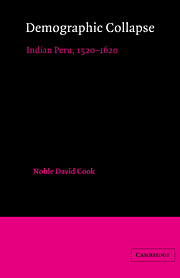Book contents
- Frontmatter
- Contents
- List of tables, figures, and maps
- Preface
- Introduction: The problem in perspective
- Part I Peru's preconquest population
- Part II Demographic collapse
- 8 First contact: north coast
- 9 Center of Spanish control: middle coast
- 10 Disease, earthquakes, and droughts: south coast
- 11 Intermediate area: northern highlands
- 12 Mining and population in the central sierra
- 13 The Indian heartland: southern highlands
- 14 An overview
- Abbreviations used in notes
- Notes
- Bibliography
- Index
- Titles in the series
8 - First contact: north coast
Published online by Cambridge University Press: 02 December 2009
- Frontmatter
- Contents
- List of tables, figures, and maps
- Preface
- Introduction: The problem in perspective
- Part I Peru's preconquest population
- Part II Demographic collapse
- 8 First contact: north coast
- 9 Center of Spanish control: middle coast
- 10 Disease, earthquakes, and droughts: south coast
- 11 Intermediate area: northern highlands
- 12 Mining and population in the central sierra
- 13 The Indian heartland: southern highlands
- 14 An overview
- Abbreviations used in notes
- Notes
- Bibliography
- Index
- Titles in the series
Summary
The infinite abundance of humanity, during the passage of many years, which this New World propagated, was such that there scarcely remained a corner, however remote or hidden it might be, that the native inhabitants did not search for, discover, and settle, … there came an abundant multiplication of people, which gave such a filling of this section of the world, that men were not lacking for land, but land for people.
Miguel Cabello de Balboa, Miscelanea antartica, pp. 220–1There are three distinct ecological systems in Peru: the coast, the highlands, and the montaña with the Amazon basin. Each of the regions has its own set of unique characteristics and is subject to its peculiar internal divisions. Common to all the Peruvian coast, and the factor that contributes to its special climate, is the Humboldt current. That broad river, flowing in a counterclockwise fashion in the eastern South Pacific, sweeps cold Antarctic water along the South American coast. The prevailing westerly winds push the air, cooled by the water, against the unbroken Andean chain, which in places surpasses 6,000 meters in elevation. The result is an area of high barometric pressure. Almost no rain falls along the mid-Chilean to north Peruvian coasts. The consequence is a narrow desert strip some 3,000 kilometers in length. As the air rises along the western Andean slopes, moisture condenses. In some areas, at roughly 600–1,500 meters in elevation, the moisture forms a fog or garua. At higher altitudes there is seasonal rainfall and at the highest points snow, which provide the water for coastal rivers and irrigation systems.
- Type
- Chapter
- Information
- Demographic CollapseIndian Peru, 1520–1620, pp. 119 - 144Publisher: Cambridge University PressPrint publication year: 1982



